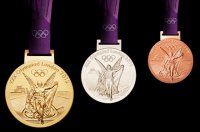AWARD-WINNING HOMEWORK HELP
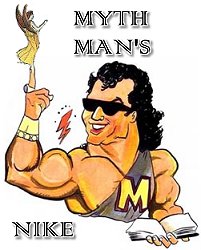
MYTH MAN'S NIKE
WINGED GODDESS OF VICTORY
LATIN - VICTORIA
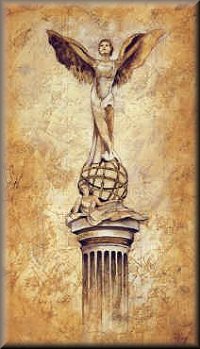
| Nike is the winged goddess of Victory, Speed and Strength, able to race and fly at great speed. |
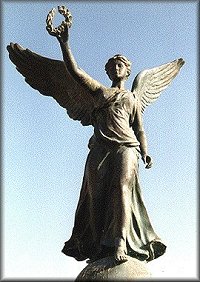 |
| She was represented in statues and paintings as a woman with wings, dressed in billowing robes, with a wreath and/or a palm branch in her outstretched hand. |
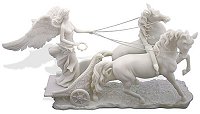 CLICK TO ENLARGE |
| After receiving a gift of a golden chariot from Zeus, Nike assumed the role of the divine charioteer to him, a role in which she often is portrayed in Classical Grecian art. |
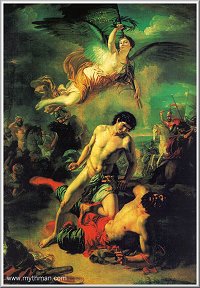 CLICK TO ENLARGE |
| Nike flew around battlefields, rewarding the worthy victors with glory and fame, symbolized by a wreath of laurel leaves. |
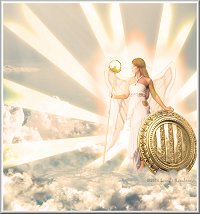 CLICK TO ENLARGE 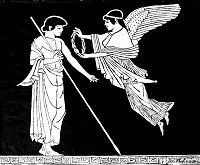 CLICK TO ENLARGE 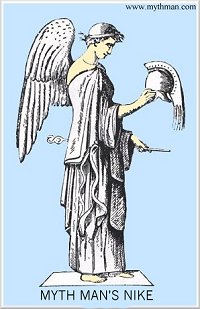 CLICK TO ENLARGE |
"O powerful Nike, by
men desired, with adverse breasts to dreadful fury fired, thee I invoke, whose
might alone can quell contending rage and molestation fell. ‘Tis thine in battle
to confer the crown, the victor's prize, the mark of sweet renown; for thou
rulest all things."
Orphic Hymn 33 to Nike
Nike is the winged goddess of Victory, Speed and Strength, able to race and fly
at great speed. Nike flew around battlefields, rewarding the worthy victors with
glory and fame, symbolized by a wreath of laurel leaves. She also appears
carrying a palm branch, a wreath, or the staff of Hermes.
She was represented in statues and paintings as a woman with wings, dressed in
billowing robes, with a wreath and/or a palm branch in her outstretched hand.
She is also often shown with the staff of Hermes, which represents her role as
the messenger of Victory.
Nike is also portrayed erecting a trophy, or, frequently, hovering with
outspread wings over the victor in a competition
The Romans called her Victoria.
Oddly enough, even though Nike is one of the oldest ancient Greek goddesses,
predating even the mighty Olympians, she doesn't figure prominently in many
myths.
Nike is often found in the company of the goddess of Wisdom and War, Athena, who
never puts up with defeat. Not surprisingly, she is also frequently portrayed
seated next to Zeus, the King of the Olympians, or even being held by him or
Athena in their open palms.
The ancient poet Pausanias, in his Description of Greece 1. 1. 3 has this to say
about Nike's statue in Attica:
"In the temple of Zeus at Peiraios in Attika: The images
are of bronze; Zeus holds a staff and a Nike."
It was natural for the ancient Greeks to associate Victory with Zeus and Athena
- after all, these two powerful deities were not accustomed to losing.
Nike fought on the side of Zeus in his famous battle against the Titans, and
assisted him in gaining victory over his fearsome rivals. As a result of this
epic battle, Zeus gained control of Mount Olympus and became the supreme
Olympian.
According to classical myth, their mother Styx brought Nike, and her siblings
Zelos, Cratos and Bia, to the leader of the uprising, Zeus, when the young god
was assembling allies for the Titan War against the older deities.
After receiving a gift of a golden chariot from Zeus, Nike assumed the role of
the divine charioteer to him, a role in which she often is portrayed in
Classical Grecian art. All four siblings were appointed as sentinels, standing
guard beside the throne of Zeus.
Zeus rewarded Styx following his victory over the Titans by turning her into the
famous Underworld river Styx, upon whose waters the gods swear their oaths.
Hesiod, the Greek poet, in his epic poem called Theogony (Birth of the Gods),
gives a terrific account of how Nike and her siblings came to the aid of Zeus:
"And Styx the daughter of Okeanos (Oceanus) was joined to
Pallas and bare Zelos (Emulation) and trim-ankled Nike (Victory) in the house.
Also she brought forth Kratos (Cratus, Strength) and Bia (Force), wonderful
children.
"These have no house apart from Zeus, nor any dwelling nor path except that
wherein God leads them, but they dwell always with Zeus the loud-thunderer.
For so did Styx the deathless daughter of Okeanos plan on that day when
the Olympian Lightener called all the deathless gods to great Olympus,
and said that whosoever of the gods would fight with him against the
Titans, he would not cast him out from his rights, but each should have the
office which he had before amongst the deathless gods.
"And he declared that he who was without office and rights as is just. So
deathless Styx came first to Olympos with her children through the wit
of her dear father. And Zeus honoured her, and gave her very great
gifts, for her he appointed to be the great oath of the gods, and her children
to live with him always. And as he promised, so he performed fully unto them
all."
The Nike of Samothrace, or Winged Victory is widely acknowledged as one of the
finest pieces of Hellenistic sculpture. Discovered on Samothrace in 1863 and now
in the Louvre Museum, Paris, it was probably erected by Rhodians about 203
BCE to commemorate a sea battle. Excavations have shown that the sculpture was
placed alighting on a flagship, which was set in the ground in such a way that
it appeared to float.
The statue of Nike at Athens is portrayed without wings and is called Nike
Apteron (Wingless Victory). The Athenians took away her wings to signify her
permanence in their city - she would not fly away, they believed.
There are two main versions of Nike's
parentage:
1) Pallas and Styx - Pallas is son of the Titan
Crius and Eurybia, daughter of Pontus & Gaia (Mother Earth). Styx
is a daughter of the Titan Oceanus (Ocean), and a prominent river in the
Underworld.
2) Ares and unknown - Ares is the god of war.
Nike lives on Mount Olympus with her brothers Zelus (also known as Zelos), Cratos and Bia.
You can better understand Nike's nature by taking a closer look at her brothers:
Zelus ("Zeal, Rivalry") is the personification of rivalry
or emulation. He is the son of Styx and the Titan Pallas and is the constant
companion of Zeus. Cratos ("Strength, Supremacy") is the
ancient Greek personification of strength, and dominance. Like his other
siblings, he is a constant and vigilant companion of Zeus. Bia ("Force") is
the personification of power and force. Bia was most famous for being the one
who was made to bind to a rock the mighty Titan Prometheus as punishment from
Zeus. He was sentenced for stealing fire from the gods and delivering it to
humans on earth, contrary to Zeus' orders.
There was nothing sweeter for the ancient Greeks than to taste the sweet fruits
of Victory, be it in war, in love or in athletics. This is a passion which
survives to this day, and the thrill of Victory is one of the best feelings in
the world.
Nike is one of the most commonly portrayed figures on ancient coins. Even today,
since Giuseppe Cassioli's design for the 1928 Summer Olympics, the obverse face
of every Olympic medal bears
Nike's figure holding a palm frond in her right hand and a winner’s Laurel crown
in her left.
As previously mentioned, Nike was depicted in ancient Greek vase paintings with
a variety of attributes, including a wreath or sash to crown a victor, a bowl
and cup for victory drinks, an incense burner, an altar, and a lyre for the
celebration of victory in song.
In scenes of the Gigantomachia (War of the Giants) she often appears driving the
chariot of Zeus. In mosaic art and coins Nike is often shown holding a palm
branch as a symbol of victory. She is also shown inscribing the victory of the
conqueror on a shield.
Many modern companies have taken their names from Greek mythology, in an effort
to present a winning image. The most famous one, of course, is Nike, the
international sporting goods giant. Who wouldn't want to associate their product
with winning?
Besides the famous shoe company Nike,
Project Nike, an
American anti-aircraft missile system is named after the goddess Nike.
The first FIFA World Cup trophy, celebrating the winner of the world soccer
championship held every four years, featured a figure of Nike holding a vessel.
It was called "Victory".
The exclusive car company Rolls Royce features Nike as a hood ornament on their
automobiles. As well, the Honda Automobile Company's logo is inspired by goddess
Nike.
Many names have originated from Nike. These include Nick, Nicholas,
Nikolaos, Nicola, Nicolai, Nikolai, Nicolae, Nils, Klaas, Nicole, Ike, Niki,
Nikita, Nika, Niketas and Nico.
The plural of Nike is Nikai. Here is a piece from Pausanias, Description of
Greece 5. 11. 1 :
"In his [the statue of Zeus in his temple at
Olympia] right hand he carried a Nike, which, like the statue, is of ivory and
gold; she wears a ribbon and--on her head--a garland . . .
"There are four Nikai (Victories), represented as dancing women, one at each
foot of the throne, and two others at the base of each foot."

| Nike is often found in the company of the goddess of Wisdom and War, Athena, who never puts up with defeat. |
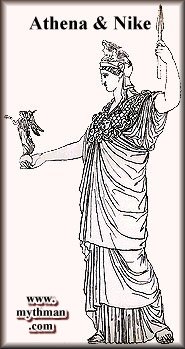 |
| She is also frequently portrayed seated next to Zeus, the King of the Olympians, or even being held by him or Athena in their open palms. |
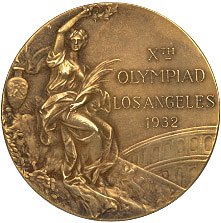 1932 LOS ANGELES |
| Nike is one of the most commonly portrayed figures on ancient coins. |
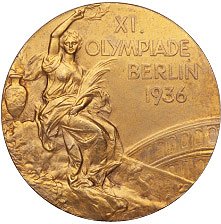 1936 BERLIN |
| Even today, since Giuseppe Cassioli's design for the 1928 Summer Olympics, the obverse face of every Olympic medal bears Nike's figure holding a palm frond in her right hand and a winner’s Laurel crown in her left. |
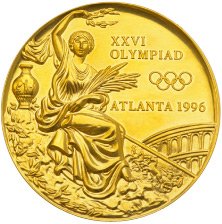 1996 ATLANTA 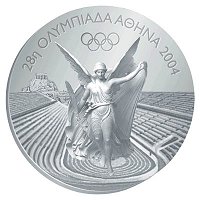 2004 ATHENS 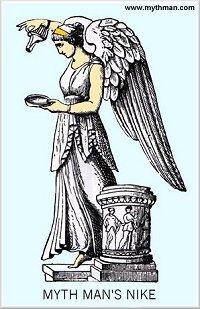 CLICK TO ENLARGE |
[HOME]
[MYTHOLOGY'S
EFFECTS ON MODERN SOCIETY] [OLYMPIANS]
[GALLERY]
[MAJOR GODS]
[MINOR GODS]
[HEROES]
[CONTACT]
[LOVE STORIES]
[MYTH OF THE
MONTH] [FUN
STUFF] [CREATURES]
Web, myth narration and graphics created and maintained by Nick Pontikis
Copyright © 1995 Nick Pontikis
Thanasi's Olympus Greek
Restaurant
Copyright 1999 mythman.com
greekmythologytoday.com
mythmaniacs.com
The Myth Man persona copyright 1988 Nick Pontikis
